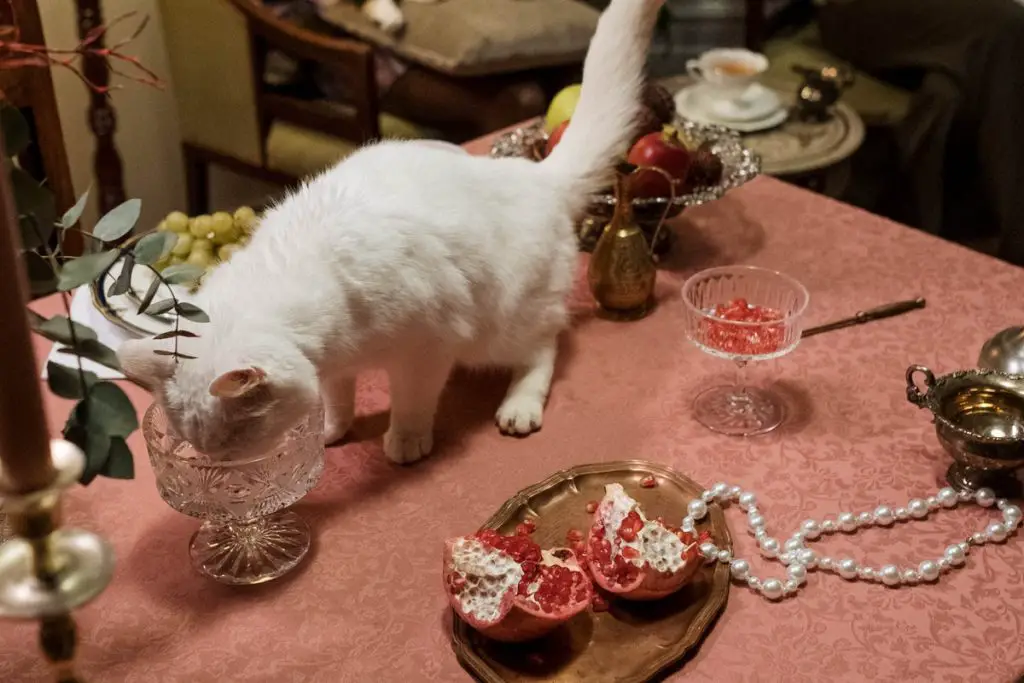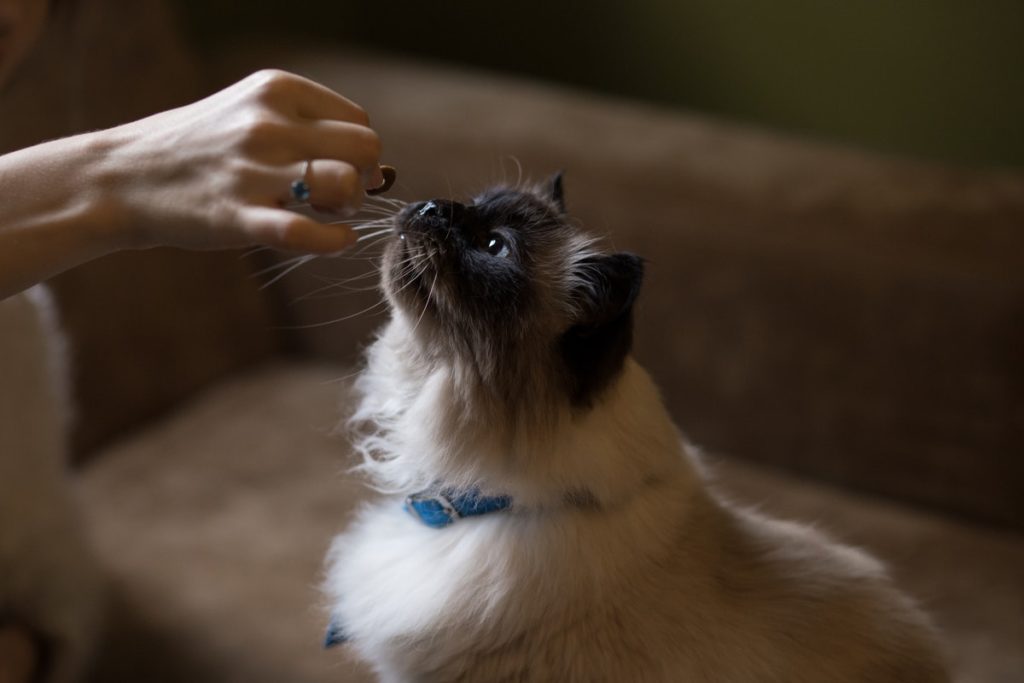Ah, cats. They’re wonderful. They are beautiful. And they are graceful little creatures.
They are some of the most composed animals we have allowed into our homes and into our hearts over the years.
They carry themselves with such poise and intelligence that it can feel like they are judging us.
Any cat owner will happily tell you about the soft glares their feline friends give them on occasion.
It only serves to heighten that sense of mystery and wisdom they hold when they are sitting meditatively in one of their many hangs in our homes.

Which makes it all the more strange, and often hilarious, when they remind you that they do some of the strangest and ridiculous things.
Struggling to open doors. Getting surprised by the cucumber. Pulling funny poses whilst trying to be intimidating.
Cats have a funny way of reminding us that they are still animals. Lovable, furry, and silly animals.
This also extends to eating things that they really shouldn’t eat. Which is what this article is about.
Either due to a cat sniffing and licking food that doesn’t belong to them, or being given it as part of a seafood diet, many people have wondered whether it is safe for cats to eat oysters.
They seem to love eating fish, so does this love and tolerance of seafood extend to the shelled variety? Well, that’s what this article hopes to resolve.
We’re going to look at cats’ diets, a little information about oysters, whether it is safe for cats to eat them, and if it is safe for them to eat any other kind of shelled seafood or mollusk.
The Diet Of A Cat
Cat food can be purchased in a variety of different types; dry food, canned food, or as a raw meat diet.
The raw meat diet is an excellent choice for cats that have special dietary needs such as allergies, or even if you just want to try it out as a new diet.
Many people also feed raw diets to their pets and cats to help with weight loss.
This is because the protein component of raw foods contains fewer calories per gram than other forms of cat food.
Cats are also fans of many kinds of seafood.
Cats and fish go together like peanut butter and chocolate, and it’s practically a stereotype of cats to love pretty much any kind of scaly fish, including tuna, salmon, and sardines.
Oilier fish is a particular favorite of many cats, and the health benefits they give these little household predators are well documented.
So, we know cats can eat some kinds of seafood, but does that include shelled seafood?
A Little Info On Oysters
Oysters are bivalves – shellfish that live in pairs, one side of which rests on the bottom of the ocean while the other side hangs suspended above it.
There are actually two varieties of oysters: the Eastern oyster and the Pacific oyster, although there are more varieties of oysters out there, these two make up the majority.
Eastern oysters are particularly high in omega 3 fatty acids and are a great source of calcium as well as zinc and iron.
Pacific oysters grow mostly off the coasts of California and Oregon. These oysters are larger than their eastern counterparts, growing between four and six inches long.
The shells are flatter than those of the eastern oyster and vary in color from pale blue to deep black.
The flavor of the Pacific oyster has been likened to “a sweet vanilla custard”, however they contain no pearls.
Although most people know oysters as a delicacy, they are actually quite low in fat.
As a matter of fact, the only type of fat they contain is phospholipids, which are essential for cell membrane function.
Oysters contain some vitamins and minerals, namely B12 and magnesium, although not nearly as much as beef liver.
In general, oysters are very nutritious and low-calorie, making them perfect for anybody looking to lose weight without sacrificing nutrition.
Can Cats Safely Eat Oysters?

So, now that we have covered the basics, we can get to the main question: Can cats eat oysters?
Well, the short answer to this question is: No.
The long answer is a little more complicated. But the most important detail you should know is that oysters should never be fed to cats.
They contain enzymes that destroy thiamine, a vitamin that helps cats stay alive. Cats need thiamine to stay healthy.
Eating oysters could cause neurological problems, seizures, and coma. Oysters contain harmful bacteria that can make your cat sick or even kill them.
Cooking oysters might help kill the dangerous bacteria but does not remove the toxin that attacks the cat’s gut and nervous system.
Not to mention that often oysters are larger than a cat’s esophagus, which means that there is a danger of cats choking to death even before it reaches their stomach to wreak havoc on a cat’s body.
In short, when you consider that even a person eating an oyster can have dire consequences for them if not prepared correctly, you can imagine the sort of damage it can do to a cat.
Their bodies are just not like ours, and they don’t absorb or get rid of nutrients in the same way as we do.
This rule also applies to other oyster-related foods.
Oyster sauce is equally off-limits for cats, as the preservatives and additives that are put into the sauce cannot be digested by cats safely.
What Shelled And Mollusk Seafood Can Cats Eat?
So, we have discovered that cats cannot, and should not, be fed oysters as part of their diets.
We are now left with another question: If cats can’t eat oysters, is there any other shell food that they can eat?
Mussels
Another bivalve species of shellfish, mussels are an excellent source of protein, vitamins, minerals, and essential oils, even for cats.
You can feed your cat mussels if you want, but make sure that they are only given rarely.
Mussels are high in thiamine, which can lead to long-term health problems for cats, and their high salt content is not ideal.
Clams
Clams actually can be eaten by cats, although only in small quantities, and from trusted sources.
Their high-sodium quality can be a danger if not treated correctly, and their high-salt content can damage their kidneys and liver if eaten in large quantities.
Simply put, this is a very rare gift that cats can have, and nothing more.
Scallops
Scallops are bivalves and mollusks. They have a shell, but they are not hard to open. They can be grilled, sautéed, baked, boiled, deep-fried, and soon.
Cats can eat scallops as they are very nutritious in most circumstances. They are high in protein, vitamins, minerals, and essential fatty acids.
However, raw scallops should be avoided by any cat owner at all times, as the thiamine will cause health problems in your cat’s gut.
Cooking helps remove toxins from raw seafood, but they can still prove toxic if they make up a large portion of their diets.
So, if you feed this shellfish to your cat, keep the portion small, and don’t make a habit out of it.
Lobsters
Lobsters are probably one of the safer shellfish that your cats can eat.
So long as the cat isn’t allergic to seafood in general, fresh lobsters are usually safe for cats to eat in small amounts, but they mustn’t be seasoned with other ingredients that are harmful to them, like dairy products or garlic.
So, keep the portions small, save them for special occasions, and you should be fine.
Conclusion – Can Cats Eat Oysters?
So, we’ve learned that, whilst cats can eat some types of shellfish in small amounts, oysters are categorically off the menu for them.
They simply have too many dangerous bacteria inside them for cats to eat.
If you are looking for something else to give your cat instead then, try giving her some good-quality dry kibble, or even better, a cooked meaty bone.
Or, if you’re looking to really spoil your kitten, a little bit of cooked tuna. They’ll love it!

